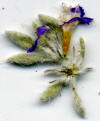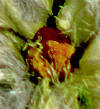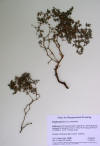|
Tiquilia canescens |
Tiquilia canescens |
|
Tiquilia canescens
|
Tiquilia gossypina Arizona Upland Desert. Navajo Co.,Vermilion Cliffs, vicinity of Cliff Dwellers, 36º43'47.8", 111º45.17.2", 1255 m. Limestone rocky soil. Richard and Susan Spjut 16230, 22 May 2008
|
|
Tiquilia greggii
|
Tiquilia hispidissima
|
|
Tiquilia latior
|
Tiquilia mexicana |
|
Tiquilia mexicana
|
|
|
Tiquilia nuttallii Great Basin Desert-Reno
Region—California. Mono Co., Inyo NF: Benton Range, Hwy 120, north of
Benton from junction with Hwy 6, east shore of lake; 37º48'56.5",
118º34’51.2”, 1972 m. Sagebrush scrub in transition to freshwater
marsh. |
Tiquilia palmeri |
|
Tiquilia plicata
|
Tiquilia plicata |
|
Moore, M. J and R. K. Jansen. 2006. Molecular evidence for the age, origin, and evolutionary history of the American desert plant genus Tiquilia (Boraginaceae). Mol. Phylogenet. Evol. 39: 668–87. “Although the deserts of North America are of very recent origin, their characteristic arid-adapted endemic plant lineages have been suggested to be much older. Earlier researchers have hypothesized that the ancestors of many of these modern desert lineages first adapted to aridity in highly localized arid or semi-arid sites as early as the late Cretaceous or early Tertiary, and that these lineages subsequently spread and diversified as global climate became increasingly arid during the Cenozoic. No study has explicitly examined these hypotheses for any North American arid-adapted plant group. The current paper tests these hypotheses using the genus Tiquilia (Boraginaceae), a diverse North American desert plant group. A strongly supported phylogeny of the genus is estimated using combined sequence data from three chloroplast markers (matK, ndhF, and rps16) and two nuclear markers (ITS and waxy). Ages of divergence events within the genus are estimated using penalized likelihood and a molecular clock approach on the ndhF tree for Tiquilia and representative outgroups, including most of the major lineages of Boraginales. The dating analysis suggests that the stem lineage of Tiquilia split from its nearest extant relative in the Paleocene or Eocene ( approximately 59-48 Ma). This was followed by a relatively long period before the first divergence in the crown group near the Eocene/Oligocene boundary ( approximately 33-29 Ma), shortly after the greatest Cenozoic episode of rapid aridification. Divergence of seven major lineages of Tiquilia is dated to the early-to-mid Miocene ( approximately 23-13 Ma). Several major lineages show a marked increase in diversification concomitant with the onset of more widespread semi-arid and then arid conditions beginning in the late Miocene ( approximately 7 Ma). This sequence of divergence events in Tiquilia agrees well with earlier researchers' ideas concerning North American desert flora assembly.” |
|


















